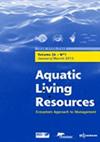东京湾半祖潮区2000年代收获减少期间的马尼拉蛤产量
IF 1.9
4区 农林科学
Q3 FISHERIES
引用次数: 0
摘要
在东京湾,自20世纪90年代末以来,马尼拉蛤的可采收量一直在减少。本研究于1988年4月至2014年12月对板祖养殖区的蛤蜊密度进行了实地调查,并收集了1986年1月至2017年9月相关渔业合作协会的记录,以阐明种群丰度的时间变化与渔民生产活动的关系。在研究期间,蛤蜊丰度的年变化标志着大型蛤蜊数量的大幅减少。在1980年代后期,尽管可收获的蛤蜊数量很高,但仍可能有大量超过养殖区域生物生产力的幼蛤作为种子资源引进。收获数量的下降始于20世纪90年代末,可能是由于可收获种群的减少造成的,尽管种子种群不断增加。收获数量可能显著依赖于野生蛤种群,即使在养殖区内也是如此,因为收获数量与研究期间引入的种子数量无关。采伐数量的下降可能是由于可采伐库存水平低导致作业采伐者数量减少,从而降低了盈利能力。强调了两项发现。基于对野生和引种蛤对未来种群生物量贡献的预测,某种管理方式对于经济上可行的养殖至关重要。在可采收量较少的地区,即使总采收量减少,也应采取措施维持采集者的收入,同时避免过度开采。本文章由计算机程序翻译,如有差异,请以英文原文为准。
Production of asari (Manila) clams, Ruditapes philippinarum, during the period of harvest decrease in the 2000s in the Banzu tidal area, Tokyo Bay
In Tokyo Bay, the harvestable quantity of asari (Manila) clams Ruditapes philippinarum has been decreasing since the late 1990s. We conducted a field investigation on clam density in the Banzu culture area from April 1988 to December 2014 and collected records spanning January 1986 to September 2017 from relevant fisheries cooperative associations to clarify the relationship between the temporal variation in stock abundance and the production activities of fishermen. The yearly variation in clam abundance over the study period was marked by larger decreases in the numbers of larger clams. A large quantity of juvenile clams, beyond the biological productivity of the culture area, may have been introduced as seed stock in the late 1980s despite the high level of harvestable stock. The declines in harvested quantity began in the late 1990s and may have been caused by decreases in harvestable stock despite the continuous addition of seed stock clams. The harvested quantity is likely to be significantly dependent upon the wild clam population, even within the culture area, as the harvestable quantity was not correlated with the quantity of seed stock introduced during the study period. These declines in harvested quantity may have resulted from a decreasing number of operating harvesters due to the low level of harvestable stock and consequently reduced profitability. Two findings were emphasized. A certain management style, based on predictions of the contributions of wild and introduced clams to future stock biomass, is essential for economically-feasible culturing. In areas with less harvestable stock, actions should be taken to maintain the incomes of harvesters while avoiding overexploitation, even if the total harvest quantity decreases.
求助全文
通过发布文献求助,成功后即可免费获取论文全文。
去求助
来源期刊

Aquatic Living Resources
农林科学-海洋与淡水生物学
CiteScore
2.30
自引率
0.00%
发文量
10
审稿时长
>24 weeks
期刊介绍:
Aquatic Living Resources publishes original research papers, review articles and propective notes dealing with all exploited (i.e. fished or farmed) living resources in marine, brackish and freshwater environments.
Priority is given to ecosystem-based approaches to the study of fishery and aquaculture social-ecological systems, including biological, ecological, economic and social dimensions.
Research on the development of interdisciplinary methods and tools which can usefully support the design, implementation and evaluation of alternative management strategies for fisheries and/or aquaculture systems at different scales is particularly welcome by the journal. This includes the exploration of scenarios and strategies for the conservation of aquatic biodiversity and research relating to the development of integrated assessment approaches aimed at ensuring sustainable and high quality uses of aquatic living resources.
 求助内容:
求助内容: 应助结果提醒方式:
应助结果提醒方式:


